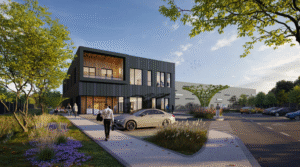When planning to move to a new modern office space, the cost is often considered from the wrong angle – looking at the old financial figures is a miscalculation. New and high-quality spaces may seem expensive at first glance, but what truly matters is something else, writes Eduard Sorokin, the Head of the Office and Retail Department at Uus Maa Commercial Real Estate, in an opinion piece discussing the advantages, disadvantages, and opportunities of new and old office spaces.
A new Class A building is like a young, healthy athlete. The health, technical quality, and overall attractiveness of an older Class B building depend on the owner’s diligence, capital investment, and care for the building. As it approaches middle age, one person may play top-level football, while another might be unfit for sports, comparing this to a building.
Why choose Class A offices over Class B ones?
There are at least two important classification scales for buildings: based on quality and location.
Quality classification. Class A buildings have objective technical characteristics, including air quality, flexibility of layout, energy efficiency, low noise levels (related to technical system noise, sound insulation within the building, external noise), parking facilities, elevator speeds. Important visual characteristics include the building’s exterior, interior common areas, finishing materials, signage, decorations, lighting solutions, artwork.
Buildings with international quality certifications (such as BREEAM) are the top of Class A. Local branches of international corporations, whose internal policies are aligned with an environmentally conscious worldview, prefer such buildings.
It’s not far off when local progressive companies and institutions like government agencies, healthcare facilities, educational institutions will take the same direction – to operate in environmentally conscious buildings.
The world around us is a reflection of our inner world. This might be the most accurate answer to the question of “why choose Class A over Class B”. A company’s external image, internal culture, employee motivation are influenced by the environment in which people work, where clients visit, where partners are received. Even in headhunting, the location and the building quality play an essential role in attracting talent.
When planning to move to a new modern office space, the cost is often considered from the wrong angle. New and high-quality may indeed seem unusually expensive. But comparing with old figures is a miscalculation. In practice, companies that have made the quality leap tend to quickly expand their client base, leading to increased revenue and eventually staff expansion. The best deserve the best, and they know it. They are willing to pay more for the best.
Class A buildings are usually developed by experienced professionals. New technologies and trends are added to existing wisdom. The more daring developers take extra steps, adding something unique, some expensive addition that gives the building an exceptional character. Such extravagances may not please the financial director in the project’s feasibility calculation, but in practice, a new feasibility calculation needs to be done upon completion. Tenants are willing to pay a premium price for space in a special building. Notable examples in Tallinn’s office landscape include Explorer (Kai 1), Skyon (Maakri 30), and certainly the upcoming Golden Gate (Ahtri 6) in 2024. In Tartu, the Gardest Green Park (Tartu-Tiksoja 21) falls into this category.
Are Class A office spaces always cheaper to manage than Class B ones?
Class A office spaces are not always cheaper to manage, as the complex technical and visual solutions require more maintenance. However, Class A buildings and buildings with quality certifications are generally significantly cheaper to heat and cool. In practice, all operating costs can be of the same magnitude in both Class A and B/C buildings.
The most important factor is something else – in a building with a modern climate system, people can breathe normally. Insufficient oxygen and humidity levels in the air are the biggest issues in older buildings. Employees with oxygen deficiency make more mistakes, are more prone to illnesses, and possibly resent their workspace. Other notable issues include imbalances in heating systems causing excessively hot or cold areas, noisy cooling systems, sound insulation, odors, and other not-so-pleasant specifics that come along with companies looking for the “cheapest price”.
Will Class B office spaces start to become vacant?
We’ve noticed a trend that vacancies are increasing and lengthening in Class B/C buildings. This, in turn, creates pressure on prices. At times, we’ve seen absurdly low rental offers. For example, some roughly 15-year-old office buildings in Tallinn’s Pärnu mnt business district stand out – anonymous and cold-looking boxes where navigating between slashes and letters to find the correct entrance can sometimes be a real challenge.
Increasing vacancies along with decreasing rental rates, all against the backdrop of high energy prices and rising interest rates, only means one thing – the model is not sustainable. Now is the time to take decisive and vigorous action with such assets.
What can be done with these buildings? In principle, there are four options: sale, thorough renovation, change of function, or demolition and maximizing construction rights. The choice depends on several factors, the most important being the building’s location, structural condition, and adaptability, as well as the owner’s financial capabilities.
Perhaps it’s worth reconsidering regulations at the national or local level that concern changing the function from commercial to residential. I believe that our urban environment would benefit from some cool, unique loft-style apartment buildings as a result.
Can older office spaces be renovated so that their maintenance costs are equivalent to modern Class A office spaces?
Older buildings can be thoroughly renovated. The best examples in Tallinn are Kawe Plaza (Pärnu mnt 15), Maakri HUB (Maakri 23a), and Rocca Business Center (Paldiski mnt 96). Successful renovation projects usually involve an all-in-one approach. All technical systems, facades, as well as visual elements like lighting, entrance logic, and other attributes that together give the building a modern, fresh appearance and cost-effective technical systems need to be renewed.
The feasibility of a reconstruction project is absolutely individual for each specific building. When developing a vision and creating a business plan, it’s advisable to involve consultants specializing in commercial real estate, who can assist in mapping market demand and developing a viable product format.
Source: Äripäev / Kinnisvarauudised.ee




